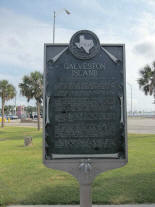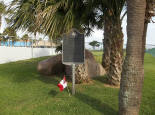|
 Dignified
Resignation Dignified
Resignation
(2012)
Enlarge This statue was
sculpted by Louis Amateis and dedicated June 3, 1912. The photo was taken
on the 100th anniversary of the dedication-June3, 2012 The statue is in
the Galveston County Courthouse Square, Galveston, Texas.
From the rededication program " The monument is inscribed Dignified
Resignation and is interpreted: The bronze figure stands with his broken
sword, and behind him is a dismantled and useless cannon with a cannonball
balanced on top. An anchor and foliage are under the cannon. Defeated, yet
his head is raised proudly and in his hand the flag of the Confederacy
which he presses to his heart in a last act of farewell and honor."
In 1910 funding to commission the monument was from the United Daughters
of the Confederacy Veuve Jefferson Davis 17, Galveston. Mollie R. M.
Rosenberg, President."
|
|
 Galveston
Island Marker Galveston
Island Marker
(2012)
Enlarge On State Highway 87 at
the ferry landing next to the Texas flagpole. There is a parking area,
otherwise the road ends at the ferry to Boliver Peninsula and there is
usually a line of cars ready to move when the ferry arrives, so it is best
to park in the lot if a view of the marker is desired. If possible, stop
to look across the entrance to Galveston Bay to imagine how things must
have been.
"Few spots have played a more exciting role in the life of Texas than
Galveston Island. Cabeza de Vaca, the Spanish explorer, wrote of the
cannibalistic Karankawa Indians when he was shipwrecked here in 1528. The
island became headquarters for Jean Lafitte and other adventurers between
1815 and 1821. Importance of the harbor was recognized as early as 1825
when Stephen F. Austin petitioned the Mexican government to establish a
port. Galveston became temporary capital of the Republic in April, 1836,
when President David G. Burnet fled here at the approach of Mexican Gen.
Santa Anna. After the revolution Galveston's place as first city of the
Republic became fixed. Immigrants poured through the port. The Texas Navy
was berthed here. With statehood in 1845 came continued growth; Texas
first telegraph (1854), first national bank (1865), first electric lights
(1888). Capture and recapture of Galveston were principal Texas
engagements of the Civil War. The port fell to blockading Union troops
Oct. 4, 1862. It was retaken Jan. 1, 1863, by Gen. John B. Magruder and
remained in Confederate hands. Galveston was again on the nation's lips
Sept. 8, 1900, when a hurricane packing winds of 120 mph swept a vast
tidal wave across the island, killing 5,000. No other American disaster
has taken a greater toll. The storm had two immediate results --
construction of a protective seawall 17 feet high and 7-1/2 miles long and
creation of a commission form of city government, an innovation that
spread to other American municipalities. The port remains one of the
state's most important, handling more Sulfur than any in the world.
Important to sightseers and motorists are the toll-free ferries operated
by the Texas Highway Department across the 2-1/2-mile strait between the
island and Port Bolivar." |
|
 Galveston
CSA Galveston
CSA
(2012) Enlarge
Detail This marker is
located at the Galveston Yacht Club - 4th St. (Holiday at Albacore Ave) A
security gate must be cleared before entry to the marker site.
"Most important Texas seaport during the Civil War. Had consulates of
England, France and Spain and worldwide recognition as a cotton exporter.
Set up defenses including 10 mud forts and gun batteries on beaches, at
railroad depot and on Pelican Spit. Continued shipping cotton in spite of
Federal blockade which began in July 1861. Blockade runners used speed,
shallow draft ships, wit and courage to escape the Federal ships and haul
cotton to Nassau, Havana or Europe and return with guns, medicines and
other goods essential to the Confederacy. In Oct. 1862, lack of guns large
enough to stop a Federal bombardment caused Gov. F. R. Lubbock to call for
evacuation of civilians. The 42nd Massachusetts regiment occupied the city
Dec. 25. A week later, Jan. 1, 1863, Confederates recaptured it with
forces led by Gen. John B. Magruder, Col. Tom Green and Capts. Leon Smith
and Henry Lubbock with "Horse Marines" (mounted Rangers) and "Cotton Clads"
(ships walled in cotton bales with gun embrasures). The Trans-Miss. Dept.,
last Confederate force to surrender, signed terms here June 2, 1865.
Federal occupation on June 19 proclaimed Emancipation, and ex-slaves
afterwards celebrated "Juneteenth." 1965.
|


